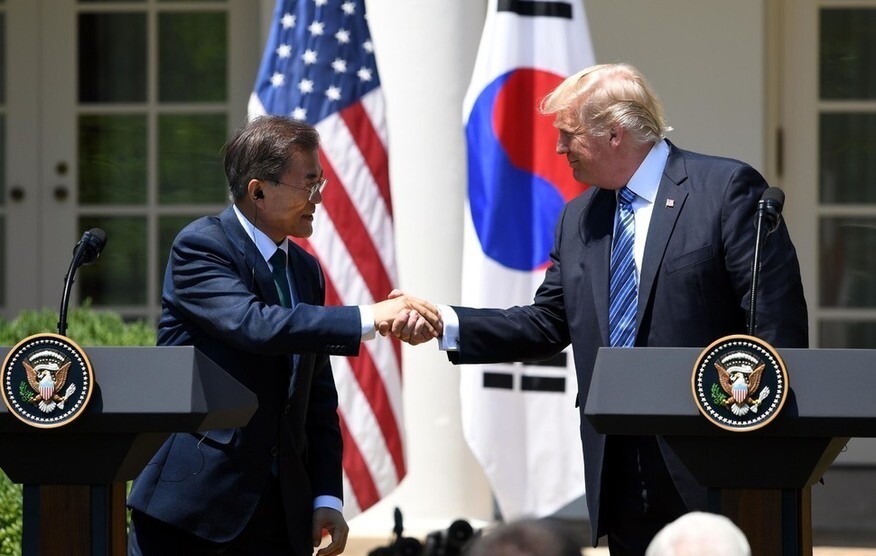hankyoreh
Links to other country sites 다른 나라 사이트 링크
[Editorial] Pres. Moon’s “four nos” can be the basis for resolving North Korea nuclear issue

South Korean President Moon Jae-in and US President Donald Trump made some progress during their first summit, with the US recognizing that South Korea should play a leading role on the North Korean nuclear issue, but the challenges that remain are every bit as substantial.
In the joint statement that was announced after the summit, South Korea and the US declared their intention to dismantle North Korea’s nuclear program through non-military means, which is to say a combination of sanctions and dialogue, rather than force. It goes to the credit of Moon and Trump that the joint statement specifies that “the door to dialogue with North Korea remains open” at a time when American public sentiment toward the North has cratered because of the recent death of student Otto Warmbier.
Most importantly, persuading the US to agree to South Korea’s “initiative” in resolving Korean Peninsula issues is likely to provide the Moon administration with crucial momentum in drafting and implementing a new roadmap for its North Korea policy. During his address to the Center for Strategic and International Studies (CSIS), a think tank in Washington DC, Moon elaborated the so-called “four nos” approach to North Korea. As they work toward North Korea’s denuclearization, Moon said, “President Trump and I aren’t engaging in a policy of hostility toward North Korea. We do not intend to attack North Korea, nor do we want the replacement or collapse of the North Korean regime. We will not artificially hasten unification of the Korean Peninsula either," North Korea should also hurry and come to the table to negotiate a solution to its nuclear program in line with South Korea and the US’s forward-looking stance.
Despite these results, the deployment of THAAD on the Korean Peninsula and the cost-sharing agreement for stationing American troops on the peninsula are issues that must still be tackled. While it’s true that Trump’s direct reference to increasing South Korea’s share of defense costs during the press conference was largely motivated by domestic politics and aimed at his support base, his personality makes it likely that he will pile on pressure during the cost-sharing negotiations. With this in mind, South Korea needs to make thorough preparations and have a contingency plan in place well in advance of the cost-sharing talks, which will begin at the end of next year.
Moon emphasized the "democratic legitimacy and procedural transparency" of the THAAD deployment and said that carrying out an environmental impact assessment does not mean cancelling THAAD.He maintained his ambiguity, but the Americans are likely to understand this to mean that THAAD will be deployed after the environmental impact assessment. Moon still has to figure out how to explain this to China, which is opposed to deploying THAAD on the Korean Peninsula. Moon will be meeting Chinese President Xi Jinping at the G-20 summit that is being held in Germany this week. It won’t be easy to keep both the US and China happy. Nevertheless, it‘s certainly the Moon administration’s job to take the lead on Korean Peninsula issues, including THAAD, while walking the tightrope between those two countries. Given that this depends on how South Korea will seize the ”initiative,“ ensuring that this summit result was not mere rhetoric, Moon’s work has only just begun.
Please direct questions or comments to [english@hani.co.kr]

Editorial・opinion
![[Column] Has Korea, too, crossed the Rubicon on China? [Column] Has Korea, too, crossed the Rubicon on China?](https://flexible.img.hani.co.kr/flexible/normal/500/300/imgdb/original/2024/0419/9317135153409185.jpg) [Column] Has Korea, too, crossed the Rubicon on China?
[Column] Has Korea, too, crossed the Rubicon on China?![[Correspondent’s column] In Japan’s alliance with US, echoes of its past alliances with UK [Correspondent’s column] In Japan’s alliance with US, echoes of its past alliances with UK](https://flexible.img.hani.co.kr/flexible/normal/500/300/imgdb/original/2024/0419/2317135166563519.jpg) [Correspondent’s column] In Japan’s alliance with US, echoes of its past alliances with UK
[Correspondent’s column] In Japan’s alliance with US, echoes of its past alliances with UK- [Editorial] Does Yoon think the Korean public is wrong?
- [Editorial] As it bolsters its alliance with US, Japan must be accountable for past
- [Guest essay] Amending the Constitution is Yoon’s key to leaving office in public’s good graces
- [Editorial] 10 years on, lessons of Sewol tragedy must never be forgotten
- [Column] A death blow to Korea’s prosecutor politics
- [Correspondent’s column] The US and the end of Japanese pacifism
- [Guest essay] How Korea turned its trainee doctors into monsters
- [Guest essay] As someone who helped forge Seoul-Moscow ties, their status today troubles me
Most viewed articles
- 1[Column] The clock is ticking for Korea’s first lady
- 2After 2 months of delayed, denied medical care, Koreans worry worst may be yet to come
- 3Hong Se-hwa, voice for tolerance whose memoir of exile touched a chord, dies at 76
- 4[Column] Has Korea, too, crossed the Rubicon on China?
- 5US overtakes China as Korea’s top export market, prompting trade sanction jitters
- 6Samsung barricades office as unionized workers strike for better conditions
- 7[Editorial] As it bolsters its alliance with US, Japan must be accountable for past
- 8[Correspondent’s column] In Japan’s alliance with US, echoes of its past alliances with UK
- 9All eyes on Xiaomi after it pulls off EV that Apple couldn’t
- 10[Correspondent’s column] The US and the end of Japanese pacifism